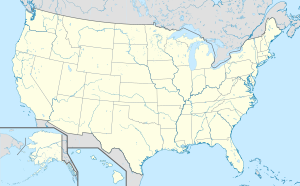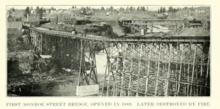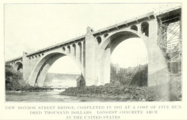Monroe Street Bridge
Coordinates: 47 ° 39 ′ 38 " N , 117 ° 25 ′ 36" W.
| Monroe Street Bridge | ||
|---|---|---|
| Monroe Street Bridge, behind it the Spokane Falls | ||
| use | Road bridge | |
| Crossing of | Spokane River | |
| place | Spokane , Washington | |
| construction | Concrete arch bridge | |
| overall length | 273 m | |
| width | 17.7 m | |
| Number of openings | three | |
| Longest span | 85.6 m | |
| completion | 1911 | |
| location | ||
|
|
||
The Monroe Street Bridge is a road bridge in the center of Spokane , Washington , USA , which crosses the Spokane River on the street of the same name .
description
The built 1909-1911 Bridge was designed by John C. Ralston, the bridge construction engineer of the city administration, which extends from the only one year younger Rocky River Bridge in Cleveland , Ohio had influence, but the span of the Monroe Street Bridge aware of one foot larger so that at the time of its completion on November 23, 1911 it had the largest span of all concrete arch bridges in the USA and was only surpassed worldwide by the Ponte del Risorgimento in Rome, which opened a few months earlier . Today it is considered the city's landmark.
The architectural design of the bridge was done by Kirtland Kelsey Cutter and Karl G. Malmgren, two respected architects active in Spokane.
The total of 273 m (896 ft) long Monroe Street Bridge has a main opening with a span of 85.6 m (281 ft), which is flanked by two mighty piers, and two side openings of 36.5 m (120 ft) each, to which further viaducts connect on the valley slopes. Its arches consist of two parallel ribs 40 m (130 ft) high and 5 m (16 ft) wide, which were created without joints and made of unreinforced concrete. They are 5.7 m thick on the fighters and taper to 2 m in the apex. On both sides of these double arches there are 5 savings arches in the main opening and 2 savings arches in the side openings to support the bridge plate. The bridge slab is divided into a 15 m (50 ft) wide, four-lane road and 2.7 m (9 ft) wide sidewalks on both sides. On the pillars above the sidewalks, there are small, rectangular pavilions decorated with stylized bison heads made of cast concrete.
history
The first bridge at this point was a wooden trestle bridge , opened in 1889 , which burned down again in 1890.
It was followed shortly thereafter by a steel cantilever bridge , which, however, showed considerable vibrations and subsidence in the middle of the bridge. It was declared unsafe in 1905 and demolished in 1909 in connection with the construction of the new concrete arch bridge.
The concrete arch bridge, opened in 1911, initially only had a trestle viaduct at its southern end, which was only replaced a few years later by concrete arches like the one on the north side.
The sight of the new bridge, the pride of the young city, was already spoiled in 1914 when the Union Pacific Railroad built a truss railway bridge across the north side arch, which was not dismantled until 1973.
In the 1990s, the condition of the bridge had deteriorated so much that demolition was planned. After protests from the population, it was finally decided to preserve the bridge, during which the arches were renovated from January 2003 to September 2005, but almost the entire rest of the bridge was rebuilt in the old style.
The Monroe Street Bridge was added to the National Register of Historic Places in 1976 .
Web links
Individual evidence
- ^ A b Spokane's third Monroe Street Bridge, the historic concrete-arch bridge, opens on November 23, 1911. At: HistoryLink.org
- ^ A b David C. Moyano, Stephen J. Shrope: Past Perfect. ( September 9, 2006 memento in the Internet Archive ) In: Civil Engineering Magazine , January 2006.





